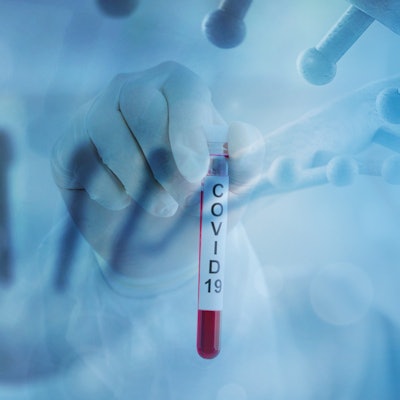
The current coronavirus pandemic is creating a new normal across all facets of daily life, and medical imaging is no exception. With the current measures in place to prevent the spread of infection, both hospitals and outpatient imaging centers have experienced a steep decline in imaging volumes, and waitlists for outpatient imaging studies are growing rapidly.
Concurrently, hospital radiology departments are faced with the complexities of carefully imaging highly infectious inpatients who are ill with the novel coronavirus, and radiologists are being asked by clinicians to "exclude COVID-19" all too often.
As a result, radiology departments are generating a wealth of new data about dealing with high volumes of complex cases, as well as characteristics of this novel coronavirus that could provide deep insights into hospital workflows, new disease states, treatment efficacy, and the long-term effects on our population.
In many radiology departments, CT, x-ray, and even point-of-care ultrasound are playing an important role in the fight against the virus. The most reliable form of testing is undeniably a nasal swab; however, as the number of available tests may not always meet demand and results can take days to return, radiology is increasingly being used as a faster method of identifying the presence of ground-glass opacities in the lungs, an indication of a possible novel coronavirus infection.
Additionally, imaging is the most reliable way to assess the severity of infection with SARS-CoV-2 and is being used to monitor treatment and progression (and hopefully recession) of the disease for hospitalized patients.
Leveraging data for real-time management of COVID-19
The collection of imaging, lab, and electronic health record (EHR) data is not only giving healthcare providers immediate care to affected patients but is also presenting opportunities to leverage this combined data to optimize rapidly changing operations. For instance, it can take up to 30 minutes to fully sanitize an imaging room and modality between patients who have tested positive for COVID-19, reducing the overall capacity in already overburdened imaging departments.
Leveraging data across all steps of the imaging workflow can help to optimize modality utilization during this period of intense need by informing imaging appropriateness and prioritization criteria to ensure the most urgent patients are imaged quickly, their reports are prioritized for interpretation, and results are delivered back to the point-of-care promptly.
Data analysis tools can also ensure follow-up recommendations are acted upon promptly and can help to avoid patients unaffected by COVID-19 who may have other clinically urgent or incidental findings becoming lost in the shuffle.
The following lists highlight only a few of the many data points captured from structured and unstructured text using natural language processing that exist within medical imaging ecosystems that could help improve real-time optimization of clinical operations and patient treatment:
Real-time data management can do the following:
- Indicate the number of patients requested for imaging to rule out, or imaged with a diagnosis of, COVID-19, SARS-CoV-2, coronavirus, or similar disease descriptions.
- Monitor and standardize procedure times, prep times, and idle times for room/modality decontamination procedures.
- Track any ordered but not-yet-performed requisitions versus wait-time and triage indications.
- Identify room or modality capacity planning in areas of less traffic and/or with better isolation.
- Proactively model and plan resource requirements during surge periods
Clinical management can do the following:
- Quantify positive and negative COVID-19-related findings across imaging modalities (CT, x-ray, ultrasound) to drive evidence-based imaging best practices and ordering appropriateness.
- Monitor and alert technologists and radiologists of COVID-19-positive patients.
- Track radiologist report turnaround times for COVID-19-related cases.
- Track duration of hospital stays, duration from diagnosis to recovery, etc.
Building a data foundation for ongoing monitoring and research of COVID-19
This real-time data can provide immediate value in patient triage and treatment, and the accumulation of this data in both radiology and other domains, such as cardiology, laboratory, and electronic health records, will continue to provide immeasurable benefits.
This data can enable healthcare providers and researchers to learn more about COVID-19, including how it presents in patients of varying demographics and predispositions, how it progresses and responds to various treatment protocols and medications, what long-term effects and comorbidities might exist, and eventually the efficacy of new-to-market drug therapies and vaccines that are currently under development.
Also, combining and correlating this wealth of data across healthcare organizations can help to identify populations at the highest risk for adverse outcomes, both short- and long-term, and can even proactively notify public health when data trends indicate the emergence of new outbreak clusters in the future.
In addition to the real-time benefits listed above, the following statistics also could be gleaned over the longer term from medical imaging datasets to support these forward-looking initiatives:
- Correlate imaging and lab results to identify patients with true positive and negative results within imaging examinations to ensure statistical accuracy.
- Identify and track patients by postal/zip code with a resulting diagnosis from COVID-19 testing.
- Track disease duration, severity, and outcomes based on patient demographics, predispositions, and comorbidities.
- Monitor the long-term impact of COVID-19 on recovered patients.
- Evaluate or find patients based on the presence of comorbidities such as chronic obstructive pulmonary disease (COPD), pulmonary fibrosis, pulmonary hypertension, and complications from COVID-19 such as new fibrosis, acute respiratory distress syndrome (ARDS), effusions, or lung abscesses.
- Correlate patient imaging results with pathology findings or other test results to track treatment efficacy.
- Monitor and prioritize patients identified for follow-up procedures.
- Identify cohorts for future radiology research (e.g., combined drug testing and radiological findings).
- Monitor for recurrence of COVID-19 (number of patients being screened a second time vs. received a second positive diagnosis).
The importance of collecting data today
One thing remains certain during these uncertain times -- that data being collected today can provide immense value now and in the future.
Our healthcare workers are fighting tirelessly on the front lines batting COVID-19. Part of this strategy must involve information systems and the widespread collection of data related to the diagnosis, treatment, effects, and spread of the virus so that physicians, researchers, and public health authorities have the evidence they will need to effectively manage and support the treatment of COVID-19 today, and be better prepared in case of future outbreaks.
Jeff Vachon is the founder of Bialogics Analytics and continues to act as president and CEO. Bialogics provides insight into product development and use cases of business intelligence to improve the medical imaging process. Prior to co-developing Bialogics, Jeff held several senior roles in healthcare informatics, including with Philips Healthcare, Cifra Telehealth, and Siemens Healthcare. With the advent of digital healthcare, Jeff was one of the first to initiate the sales and deployment of digital strategies to improve health outcomes, including PACS, telemedicine, cardiology and critical care informatics.
The comments and observations expressed are those of the author and do not necessarily reflect the opinions of AuntMinnie.com.



















